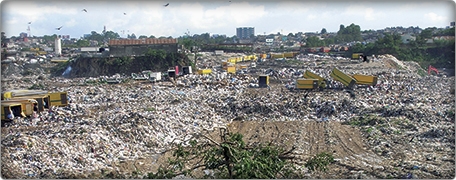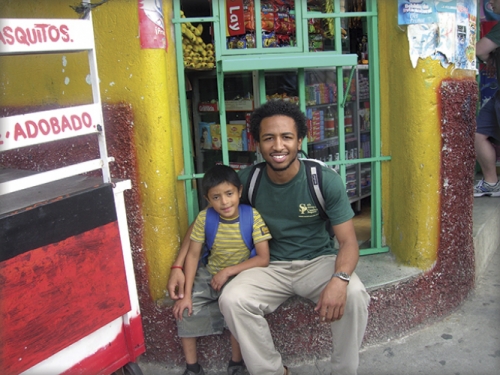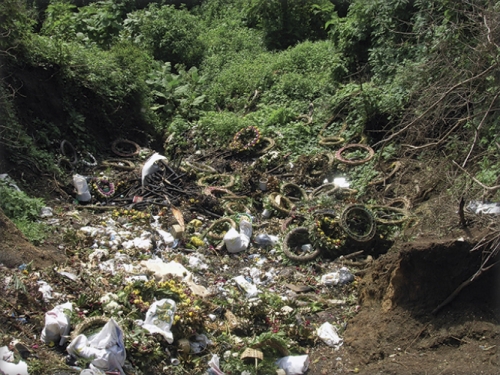They say in Guatemala that if you’re born poor, you die poor. And if you’ve ever been to the garbage dump on the edge of the capital city, you can see why.
The Guatemala City basurero covers forty acres of land with the city’s trash [Google satellite image]. Yellow trucks line up every day to tip their loads onto the heap, and residents of the slums outside the dump crowd around the trucks before they even come to a stop. Scavengers with the most seniority rush to touch the trucks’ sides — a flat palm against the cargo hold marks their scavenging space for when the trucks pull away, unleashing crumbling waves of garbage. There are stories about people charging in too quickly and getting crushed under the trucks’ tires.
Along with the tons of trash are recyclables, and the lucky hangers-on get dibs on glass, aluminum, old furniture, and any other hot commodities that come pouring out. Regulars at the dump know which trucks carry trash from supermarkets and restaurants, so every morning is a race to grab up anything edible, or that can be sold. The piles are so tall and dense that there are occasional avalanches; if someone is caught underneath, the scavengers say, their bodies are almost never found.
Until 2005, when the cloud of methane gas that hovers over the dump ignited and caused a massive fire, entire families worked, lived, and slept in the basurero, scavenging at all hours of the day and night. After the fire, though, the city built a wall around the dump and stationed armed guards to keep people out between dusk and dawn. Children were no longer allowed inside.
The basurero was closed temporarily after the fire. “And believe it or not,” Brandon Kearns says, “that took away a lot of people’s livelihoods.”
Kearns, a sophomore majoring in health policy and administration at Carolina, rode a noisy, standing-room-only school bus past the dump every day over the summer of 2007. Kearns was riding with a few other volunteers to Safe Passage, a half-day program for the children of the families working in the dump.
Safe Passage began in 1999 when a young woman named Hanley Denning, who worked with Head Start in North Carolina, opened the doors of an unused church to teach a handful of young Guatemalans. The project now includes over five hundred children.
“Public schools in Guatemala are half-day,” Kearns says, “and Safe Passage is a place for the kids during the other half. Otherwise, they would… Well, I don’t know what they would do.”
On his first day at the school, the kids ate fried chicken feet in the cafeteria and eyed the new volunteers. Before long, though, even the most hesitant kids — such as those who had never seen a black person before, Kearns says — had warmed up to them. Kearns and the others taught English, reading, and math to the kids, and played soccer with them at recess. They heard gunshots only occasionally.
It’s hard to tell where the basurero ends and the workers’ homes begin, says Cassie Hoffman, who’s been involved with Safe Passage since she graduated from Carolina in 2005. She now leads groups of volunteers, and it was through a flyer she had posted that Kearns found out about the program.
The shacks outside the dump are piled with old mattresses where families and their animals sleep eight or ten to a bed. Recyclables spill out of the windows and garbage lines the streets. The neighborhood is built on top of land that was reclaimed from the basurero years before, Hoffman says, meaning that beneath a few thin layers of sand are mounds of old, rotting garbage.
While the kids either walk or take a bus to school (a Safe Passage volunteer passes out bus tokens to the kids every day), their parents don ID tags — another innovation since the 2005 fire — and head over to the dump to get an early start.
As the scavengers pull out anything they can sell, bulldozers continually push the remaining garbage into a ravine, where they compress it and cover it with layers of sand. City officials estimate that the gorge will be full in a year or two. After that, Hoffman says, they’ll keep stacking more on top.
But it’s not just trash that ends up in the ravine. Guatemalan citizens who can afford to purchase grave plots have to pay for them annually, and payments have to keep coming even after the purchaser has died. In Guatemala City’s main cemetery — which happens to be on the edge of the dump — huge above-ground walls hold up to a hundred coffins pegged in like drawers.
“If you don’t make your payment, they pull the coffins out or dig them up, and push them down the hill into the dump,” Hoffman says. “When we went down last time, a number of them had just been pulled.”
There are no restrictions on what citizens can throw away, says Hoffman, now a master’s student of environmental management at Duke. The ravine likely contains a water source for the city, and biohazardous materials are shoveled into it every day. The conditions are ripe for a public health nightmare. Lice epidemics are common among the kids who come to Safe Passage, and outbreaks of tuberculosis are not unheard of.
Kearns and Hoffman say that the dump is fertile ground for Carolina researchers who want to get their hands dirty, including anyone studying aspects of public health, elementary education, or environmental science. And Safe Passage is always looking for dedicated volunteers, they say.
For the families who work in the basurero, Kearns says, “it’s dog-eat-dog, more or less.” So their children at Safe Passage live day to day, and the volunteers can never be sure who’ll be in class from one session to the next. But the kids are rambunctious and happy.
A few days before the end of Kearns’ stay, a little boy named Julio wanted to know when Kearns was leaving. “Cuando te vas?” he asked.
“On Friday,” Kearns answered.
“This Friday?” Julio said, his face falling.
“That’s my guy,” Kearns says affectionately. “These kids. They’ve got spirit.”






